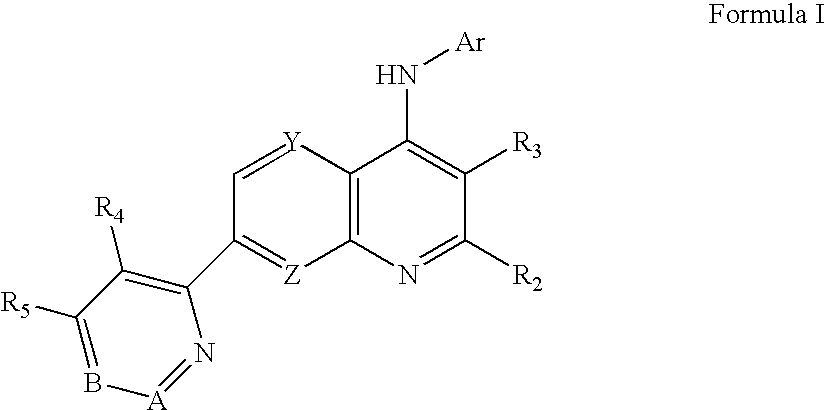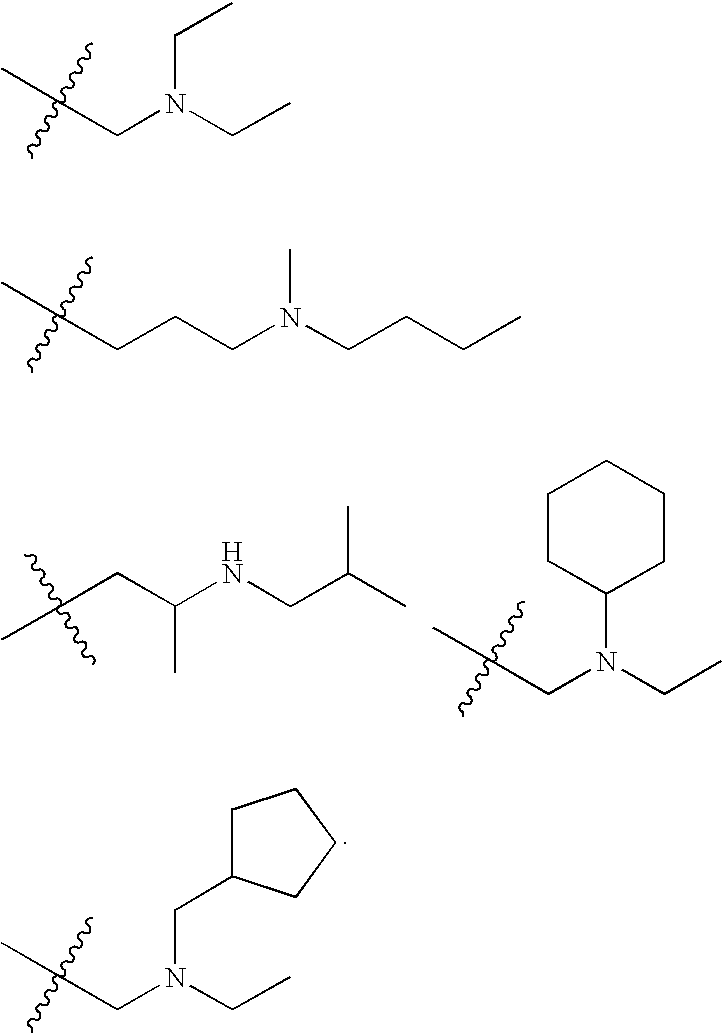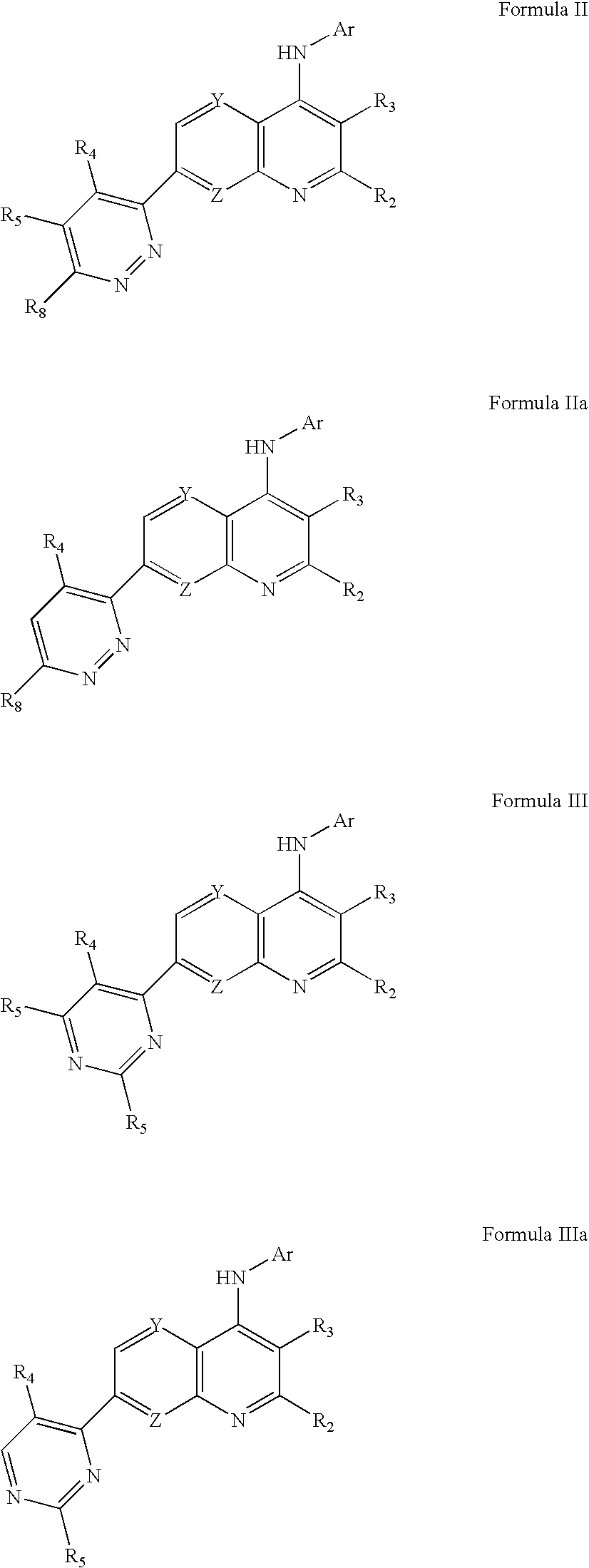Substituted Pyridazinyl- and Pyrimidinyl-Quinolin-4-Ylamine Analogues
a technology of pyridazinyl and pyrimidinyl, which is applied in the field of substituting pyridazinyl and pyrimidinylquinolin-4-ylamine analogues, can solve the problems of more debilitating, acute or chronic pain, and damage to the nervous system, and achieve the effect of promoting weight loss and reducing the calcium conductance of a cellular capsaicin receptor
- Summary
- Abstract
- Description
- Claims
- Application Information
AI Technical Summary
Benefits of technology
Problems solved by technology
Method used
Image
Examples
example 1
Preparation of Representative Intermediates
[0189]This example illustrates the preparation of representative intermediates.
A. 1-[4-(trifluoromethyl)pyridazin-3-yl]ethanone
[0190]
[0191]In a sealed tube, dissolve 3-chloro-4-(trifluoromethyl)pyridazine (200 mg, 1.10 mmol; prepared essentially as described in PCT International Application Publication No. WO 2004 / 074290) and tributyl(1-ethoxy-vinyl)tin (437 mg, 1.21 mmol) in dry toluene (5 mL). Bubble argon through the solution for five minutes. Add Pd(PPh3)4 (25.4 mg, 0.022 mmol) and heat the mixture at 110° C. overnight. Cool the mixture to room temperature and filter through Celite washing with EtOAc. Evaporate the solvent and dissolve the residue in THF (10 mL) and 3 N HCl (10 mL). Stir for 3 hours at room temperature. Add EtOAc (100 mL) and extract with H2O (50 mL), 1N NaOH (50 mL) and brine (50 mL). Dry the organic extract over Na2SO4 and evaporate. Chromatograph the crude residue on silica gel eluting first with hexane followed by h...
example 2
Preparation of Representative Pyridazinyl- and Pyrimidinyl-Substituted Quinolin-4-ylamine Analogues
A. N-[5-(Trifluoromethyl)pyridin-2-yl]-7-[4-(trifluoromethyl)pyridazin-3-yl]-1,8-naphthyridin-4-amine (compound 1)
1. 2-Amino-4-chloronicotinaldehyde
[0203]
[0204]Dissolve tert-butyl 4-chloro-3-formylpyridin-2-ylcarbamate (1.6 g, 6.2 mmol) in anhydrous CH2Cl2 (50 mL) under N2 atmosphere. Add dropwise trifluoroacetic acid (2.4 mL, 31.0 mmol) to the reaction mixture and stir at room temperature overnight. Add saturated aq. sodium carbonate (50 mL) to the reaction mixture, separate the organic layer, extract the aq. layer with CH2Cl2 (2×20 mL) and dry with MgSO4. Filter and concentrate under reduced pressure to afford the title product as a yellow solid.
2. 5-Chloro-2-[4-(trifluoromethyl)pyridazin-3-yl]-1,8-naphthridine
[0205]
[0206]Dissolve 1-[4-(trifluoromethyl)pyridazin-3-yl]ethanone (105 mg, 0.552 mmol) and 2-amino-4-chloronicotinaldehyde (86 mg, 0.552 mmol) in dry THF (10 mL). Cool the mix...
example 3
Additional Representative Substituted Pyridazinyl- and Pyrimidinyl-Quinolin-4-ylamine Analogues
[0221]Using routine modifications, the starting materials may be varied and additional steps employed to produce other compounds provided herein. For example, using the conditions described for the synthesis of N-[5-(trifluoromethyl)pyridin-2-yl]-7-[4-trifluoromethyl)pyridazin-3-yl]-1,8-naphthyridin-4-amine and substituting 6-ethoxy-5-(trifluoromethyl)pyridin-2-amine for 2-amino-5-trifluoromethyl-pyridine yields N-[6-ethoxy-5-trifluoromethyl)pyridin-2-yl]-7-[4-(trifluoromethyl)pyridazin-3-yl]-1,8-naphthyridin-4-amine (compound 5).
[0222]Compounds listed in Tables I and II are prepared using such methods. The compounds listed in Table I have an IC50 that is less than 1 micromolar in the assay provided in Example 6. LC / MS data is presented as M+1. In Table III, a “*” in the column headed “IC50” indicates that the IC50 that is less than 1 micromolar in the assay provided in Example 6.
TABLE ICo...
PUM
| Property | Measurement | Unit |
|---|---|---|
| time | aaaaa | aaaaa |
| flow rate | aaaaa | aaaaa |
| volume | aaaaa | aaaaa |
Abstract
Description
Claims
Application Information
 Login to View More
Login to View More - R&D
- Intellectual Property
- Life Sciences
- Materials
- Tech Scout
- Unparalleled Data Quality
- Higher Quality Content
- 60% Fewer Hallucinations
Browse by: Latest US Patents, China's latest patents, Technical Efficacy Thesaurus, Application Domain, Technology Topic, Popular Technical Reports.
© 2025 PatSnap. All rights reserved.Legal|Privacy policy|Modern Slavery Act Transparency Statement|Sitemap|About US| Contact US: help@patsnap.com



